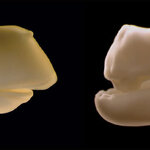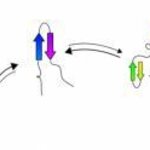Genetics & Molecular Biology

A cute little bunny has sparked renewed radiation fear in Japan. The rabbit was (allegedly) born near the severely damaged Fukushima Dai-ichi nuclear plant and has no ears (see video).
However, attributing this to the accidental radiation release after the tsunami, might be a little too presumptuous. There is no reason why it couldn't be a brith defect caused by other factors than the radiation release at the Fukushima nuclear plant.
Numerous other factors, such as natural background radiation, chemical substances, random mutations, developmental instabilities, and so on could…

We've all seen Jurassic Park. An ancient petrified piece of tree sap (or amber) is found, containing a mosquito that has been sucking dinosaur blood before its demise. A little bit of this blood is gathered, and from it (Hocus Pocus) real dinosaur DNA is extracted. Not too much later, baby dinosaurs are being born, growing up to become man-eaters.
Science fiction, of course. Or not?
Dinosaur DNA is very unlikely to be preserved for long enough periods of time for us to find some. And even if we do, it's a long way from DNA to a T. Rex. But there are dinosaur descendants roaming the…

Protein folding is where the coiled strings of amino acids that make up proteins in all living things fold into more complex three-dimensional structures. Incorrectly folded proteins in humans result in such diseases as Alzheimer's, Parkinson's, Huntington's, emphysema and cystic fibrosis, so developing better modeling techniques for protein folding is a good strategy to assist in creating more effective pharmaceutical treatments for such diseases.
By understanding how proteins fold, and what structures they are likely to assume in final form, researchers are then able to move closer…

Figuring out the structure of DNA, and the ongoing research into its workings, have provided scientists with a lot of new knowledge. One of the, perhaps unexpected, new areas of research that have sprouted forth from this knowledge, is the area of DNA computing, where DNA molecules are used to perform computational operations.
A new study has developed a DNA computer that is able to calculate the square root of whole numbers up to 15 and round the answer to the nearest whole number. By using nothing but strands of DNA, Qian and Winfree (2011), have been able to design a biochemical circuit…

Human embryonic stem cell research is limited in the US and Europe but creative researchers have made significant advances using the existing hESC lines allowed under US federal guidelines along with induced pluripotent stem cells and adult stem cells.
Scientists at Monash University's Immunology and Stem Cell Laboratories (MISCL) say they can now make precursor human stem cells from healthy adult kidneys without working on human embryos at all.
"We're taking human kidney cells and winding back the clock to make their early precursors," said Sharon Ricardo, Associate Professor
at…

In a complex system you never know what obscure change can modify things that wouldn't seem to be related. A new study shows that variation of the scavenger receptor class B type 1 gene (SCARB1)
involved in regulating cholesterol in the bloodstream also appears to affect progesterone production in women, making it a likely culprit in a substantial number of cases of their infertility. The group has developed a simple blood test for this variation of the scavenger receptor class B type 1 gene (SCARB1) but emphasize there is no approved therapy yet to address the problem in…

In the 'we need to make sure all people can abdicate any responsibility for their actions' department, a new study makes obesity exculpatory by determining that a mother's nutrition during pregnancy influences the child's risk of obesity many years later.
Whew. And here you were worried too many pizzas would influence the risk of obesity.
The downside to epigenetics studies is that they run the risk of turning legitimate aspects of biology into the DNA equivalent of evolutionary psychology by making bizarre correlation-causation claims.
The researchers measured epigenetic changes in 300…

Mitochondria are better known as the power factories of the cell but in fact they are much more interesting than that. Contrary to the old image in textbooks of round static structures, mitochondria are now known to be incredibly dynamic, shape changing, fusing and dividing according to the multitude of functions they perform in the cell. And now, in a study to be published in the journal Nature Cell Biology, scientists in Italy and Portugal show that mitochondria can also be crucial for the survival of cells during stress.
Ligia Gomes, Giulietta Di Benedetto and Luca Scorrano found…

People may object to my calling for Ph.D. programs in Theoretical Phys Ed and Quantum Paleontology, but humor is not far off the mark. Evolutionary psychology, for example, is practically self-ridiculing.
But I was somewhat intrigued by recent research I saw about stress being a genetic issue and the person behind it called it theoretical evolutionary biology. This concerns me on a few levels; first, evolutionary biology has detractors by a fringe religious minority obsessed with what Darwin did not know 150 years ago so slapping the word 'theoretical' in front…

Bananas in their natural state have up to a hundred seeds but all commercial varieties that you see in stores are seedless. Making seedless varieties made bananas wildly popular, which was good for the people who grow them and good for the people who eat them. That is a science win.
Researchers have now discovered a way to make "the most delicious fruit known to man", as Mark Twain called it, more popular with the public also. The cherimoya, or custard apple, has lots of big, awkward seeds but a group of researchers studied the seedless variety of sugar apple, a…